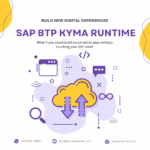Introduction
In every modern organization, the true strength of an SAP system isn’t visible on the user interface—it lies hidden beneath the surface in the infrastructure that makes everything run. SAP Basis is that critical layer. It’s not the flashy front-end application or the strategic analytics that capture headlines; it’s the silent engine that powers daily operations, ensures system stability, and maintains data integrity.
Yet, while most business leaders focus on the features and benefits of high-level applications, few understand that the foundation of a successful SAP environment starts with robust, well-managed SAP Basis. This blog examines the significance of SAP Basis, the challenges that come with managing it, and practical strategies to maintain a resilient and secure SAP landscape.
The Why: The Unseen Foundation of Enterprise Stability
A System’s Hidden Backbone
Imagine trying to build a skyscraper without a solid foundation. No matter how impressive the design or advanced the materials, the structure would crumble under pressure. In the digital realm, SAP Basis plays that foundational role. It supports everything from system performance and data processing to security and user management. Without it, even the most advanced SAP modules can fail to deliver their full potential.
The Critical Role of SAP Basis
SAP Basis is responsible for:
- System Administration: Overseeing the day-to-day operations of SAP systems, from installation and configuration to performance tuning.
- User and Security Management: Ensuring that the right people have access to the right data, while safeguarding sensitive information.
- Data Management: Handling the complex tasks of data backups, system monitoring, and recovery, which are essential for business continuity.
- Performance Optimization: Monitoring and adjusting system performance to support rapid decision-making and smooth operations.
When these functions are executed efficiently, businesses experience fewer disruptions, lower maintenance costs, and improved overall productivity.
The Problem: Challenges in Managing SAP Basis
Fragmented Processes and Complexity
Many organizations find that their SAP Basis operations are not as streamlined as they could be. Common issues include:
- Fragmented System Administration: When different teams manage various components without a unified strategy, the result is a patchwork environment where updates, patches, and security measures can fall through the cracks.
- Resource Strain: Manual processes dominate many SAP Basis tasks, from system monitoring to user administration. This not only increases the risk of errors but also ties up valuable IT resources.
- Performance Bottlenecks: Without continuous monitoring and proactive tuning, SAP systems may experience slow response times, leading to frustrated users and delayed business decisions.
- Security Vulnerabilities: Outdated or poorly managed SAP Basis environments can become weak points, exposing sensitive data and increasing the risk of cyber-attacks.
- Complex Upgrades and Maintenance: As SAP evolves, keeping up with new releases, applying patches, and ensuring system compatibility becomes an ongoing challenge, often resulting in prolonged downtime and increased costs.
The Hidden Costs
These challenges are not just technical—they have real business implications:
- Operational Downtime: Slow system performance and unplanned outages can halt critical business processes.
- Increased Total Cost of Ownership (TCO): Frequent maintenance and manual interventions drive up operational expenses.
- Risk of Non-Compliance: Inadequate system security and fragmented data management can lead to compliance issues, risking hefty fines and reputational damage.
- Employee Frustration: When IT teams are constantly firefighting due to SAP Basis issues, it hinders innovation and drains employee morale.
The question then becomes: How do we transform these challenges into opportunities for a robust, secure, and efficient SAP environment?
The How: Best Practices for SAP Basis Management
1. Establish a Unified Management Strategy
The first step in optimizing SAP Basis is to move from fragmented processes to a cohesive management strategy. This involves:
- Centralized Monitoring: Implement tools that provide a single dashboard view of all SAP Basis components. Real-time monitoring can help identify issues before they escalate.
- Standardized Procedures: Develop and document standard operating procedures (SOPs) for routine tasks such as user management, system updates, and backups. Consistency is key to reducing errors and ensuring a smooth operation.
- Automated Alerts: Use automated alert systems to notify administrators of performance dips, security breaches, or upcoming maintenance needs. Automation minimizes the need for constant manual oversight.
2. Optimize System Performance Continuously
Keeping SAP systems running at peak performance requires ongoing attention:
- Regular Performance Audits: Schedule regular audits to identify bottlenecks. Use performance metrics to pinpoint areas for improvement.
- Resource Allocation: Ensure that server resources—such as memory, CPU, and storage—are appropriately allocated to meet workload demands. Consider cloud solutions or virtualization to provide scalability.
- Load Balancing and Tuning: Implement load balancing techniques and fine-tune system parameters to distribute workloads evenly. This not only enhances performance but also prepares the system for peak usage periods.
3. Enhance Security and Compliance
Security is a non-negotiable aspect of SAP Basis management:
- User Access Controls: Implement robust role-based access control (RBAC) systems to ensure that users have access only to the data they need.
- Regular Patching: Stay up-to-date with the latest SAP patches and updates. Regular maintenance is crucial for addressing vulnerabilities.
- Data Encryption and Backup: Use encryption for data at rest and in transit. Establish a comprehensive backup strategy and test recovery procedures regularly.
- Audit Trails: Maintain detailed logs of system activity. Audit trails are essential for compliance and for quickly identifying potential breaches.
4. Leverage Automation and Low-Code Tools
Automation is not just for operational tasks—it’s a strategic tool:
- Automate Routine Tasks: Use scripts and tools to automate repetitive tasks such as user onboarding, system monitoring, and report generation. This reduces the risk of human error and frees up IT resources.
- Low-Code Platforms: Consider low-code or no-code tools to streamline process customization without heavy programming. These platforms can bridge gaps between business needs and IT capabilities.
5. Foster Continuous Improvement and Training
The landscape of technology is ever-changing, and so must be your approach to SAP Basis management:
- Regular Training: Invest in ongoing training for your IT teams. Keeping up with the latest SAP updates and best practices is crucial for maintaining system efficiency.
- Feedback Loops: Create channels for feedback from end-users and IT staff. Continuous improvement should be built into your operational strategy.
- Benchmarking: Compare your SAP Basis performance against industry benchmarks. This will help identify areas where your organization can achieve incremental improvements.
Real-World Impact: Case Studies in SAP Basis Excellence
Case Study 1: A Global Manufacturing Firm
A multinational manufacturer faced frequent system slowdowns and sporadic outages, affecting production and order fulfillment. By adopting a unified SAP Basis management strategy—with centralized monitoring and automated alert systems—the company reduced downtime by 40%. Regular performance audits and resource optimization led to smoother operations, helping the firm maintain consistent production schedules.
Case Study 2: A Financial Services Provider
A leading financial institution struggled with security vulnerabilities and compliance issues due to a fragmented SAP Basis setup. The institution implemented robust user access controls and a strict patch management schedule. With enhanced security measures and comprehensive audit trails, they not only improved compliance with regulatory standards but also restored trust among stakeholders. This strategic focus on SAP Basis management resulted in a 30% reduction in operational risks.
Case Study 3: A Retail Chain’s Digital Transformation
A major retailer found that manual interventions in their SAP Basis environment were delaying system upgrades and increasing operational costs. By automating routine tasks and leveraging low-code tools for process adjustments, the retailer streamlined its IT operations. The improved efficiency allowed for quicker upgrades and better system performance, translating into a more agile response to market trends and customer demands.
The Future of SAP Basis: A Catalyst for Resilience
The role of SAP Basis is evolving. No longer seen as just a technical necessity, it’s now recognized as a strategic asset—a backbone that supports every facet of enterprise operations. In a world where digital transformation is crucial, a well-managed SAP Basis is the key to unlocking operational excellence.
Looking ahead, the focus will shift towards even greater automation, enhanced security measures, and more seamless integrations. As businesses continue to expand and evolve, SAP Basis will remain the cornerstone of a resilient, agile, and future-ready enterprise.
Conclusion
SAP Basis is the unseen engine that drives the success of your SAP ecosystem. It ensures that data flows seamlessly, processes are executed efficiently, and systems remain secure and compliant. In today’s competitive landscape, the ability to manage your SAP Basis effectively is not just a technical requirement—it’s a strategic imperative.
By implementing best practices in system management, automating routine tasks, and fostering continuous improvement, organizations can transform their SAP Basis environment into a robust foundation that supports growth, innovation, and resilience.
The future of enterprise success depends on more than just advanced applications—it depends on the strength of the foundation that holds them together. With a strategic approach to SAP Basis, your organization can build a solid, secure, and agile IT landscape that propels you forward in a rapidly changing world.
Are you ready to rethink your approach to SAP Basis management and set your enterprise on a path to lasting success?











